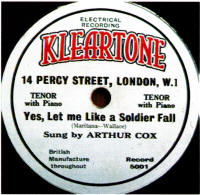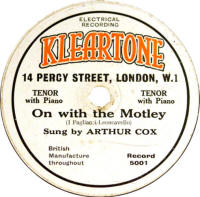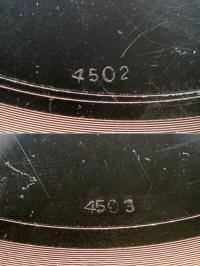| Label | Label Description | Images | ||||||||||||||||||||
| Kalliope |
Kalliope (pronounced
Kal-eye-oh-pee) were originally made in Germany for local consumption,
where they were successful for 30 years. The British equivalent was not
so successful, however. It was introduced in 1913 by the Anchor
Gramophone Company and cost 1/- , comp[eting with the very cheapest
records at the time of the 1913-14 price war. The catalogue numbers were in a 6000-series and masters were derived from German Anker & Kalliope, the latter including recordings made by J Blum & Co from their recording rooms at 220 Old Street, London. The label ceased production with the outbreak of war in 1914. |
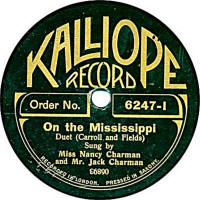 |
||||||||||||||||||||
|
Kalophone
(sold in Australia) |
These were made by English
Beka (Lindström) for export to Australia during 1913 & 1914. The
catalogue numbers matched those of the Beka issues, though it is not
known if the whole Beka catalogue was issued on Kalophone. Thanks to Adam Miller for providing the label scan. |
_small.jpg) |
||||||||||||||||||||
| Kay |
These
were made by EMI and were of recordings made in Trinidad. They date to
post-WWII. Thanks to Bill Dean-Myatt for providing the label image. |
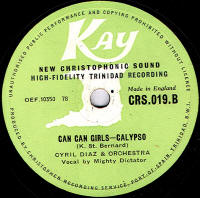 |
||||||||||||||||||||
| Keith Prowse |
Keith Prowse was a
music publisher trading at 159, New Bond Street, London. In 1927, they
issued 3 records (catalogue numbers K-101 to K-103) using Gennett
& Vocalion masters from America, & costing 3/- each. The records
were manufactured by Vocalion, UK. A complete listing follows!
Note: Frank Andrews, in For The Record 11 says that the late Eddie Shaw stated there were actually 8 different ones, numbered K-101 to K-108. However, in the following issue, Eddie Shaw himself corrected this to say there were only 3 records as seen here:
See also KP Music. |
|
||||||||||||||||||||
| Kent Messenger |
The image here shows what appears to be a special record associated wih
the Kent Messenger newspaper. It looks like a small record and probably dates from the 1920s. Any further information or a better image would be gratefully received! |
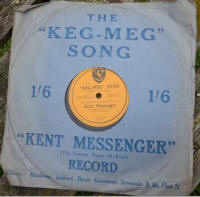 |
||||||||||||||||||||
| Key | These records were made for Selfridges during 1933 & 34. The selections were chosen by Christopher Stone (usually referred to as Britain's first "disc jockey") and were pressed by Decca using masters also available on Panachord and Winner. The catalogue was quite a small one running from S-600 to about S-630 and artists were generally cloaked in pseudonyms. |
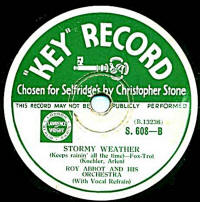 |
||||||||||||||||||||
| Kiddie |
Kiddie Record was a 6" single-faced
disc made for British Kodisk limited of 4 Ansdell Street, London W8 (which had nothing to do with
Kodak)
and sold by
Murdoch Trading Company of London. They were first advertised in April
1923 and there were 5 different records available in an album, which
cost 5/- in total. They were numbered in a 1000 series starting at
1001. The reverse side of each record is a picture illustrating
the story found on the recorded side (see example, right). It is not known
if further issues were produced, but G.A. Bryan Ltd (proprietors of
Selectaphone Machines Ltd) was still stocking them in 1925.
It is possible they are the same recordings as those with the same name being sold in America in 1922 and recorded by Emerson Records. It should be noted that British Kodisk also produced the metal "Kodisk" records for home recording purposes, and that Emerson in the US, also produced similar records under the same name. As it appears there may only be a small number of these, I will list the known ones here for now:
If anyone has any information or further examples of this label, please email me. |
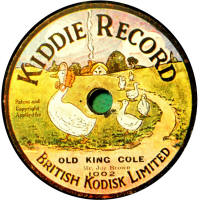 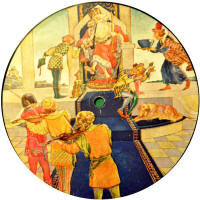 |
||||||||||||||||||||
| Kidditunes |
A children's record dating from the early 1960s. Kidditunes were 6" in
diameter and made from vinyl. They were made in England for Marx Toys
and sold by Lumar Ltd of Swansea. As you can see from the image, the
label give no performers' names nor does it give any clues to the source
of the recordings. The packet asserts that they can be played with any needle on any gramophone. Marx did produce a toy wind-up gramophone which used steel needles, but I would imagine these would make short work of a vinyl record ! Thanks to Richard Prout for the images. |
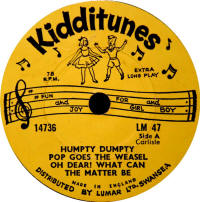 |
||||||||||||||||||||
| Kiddyphone | Obviously aimed at the younger people, these records were produced by Crystalate from about 1924 to 1930. They were initially 7" in diameter, before being reduced to 5½", then subsequently enlarged to 6". Most recordings were made specifically for the smaller size, but some were edited dubs of standard 10" Imperial issues. Most of the dance records were issued as Kiddyphone Dance Orchestra, though a few later items were, amazingly, correctly labelled "J. Wilbur's Band". |
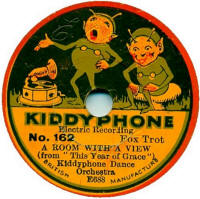 |
||||||||||||||||||||
| Kid-E-Phone |
These are 4" records, double-sided and without any catalogue numbering,
or, indeed, any numbers on the label at all, just some references in the
"wax". From the back of the sleeve we can infer there were at least 9 different records available, and most likely a matching toy gramophone. The record's surface of this example has FAB1 and FAB2 hand inscribed, which must just refer to "Fables", the title of this one, so one must assume the others have something similar - an abbreviation of the title and a number designating the side. Also in the "wax" on side 1 is the word ORIOLE (also hand inscribed) which could refer to the manfacturer being Levy Brothers who used ORIOLE as a trade name for their records. Thanks to Richard Prout for the images and informaton. |
|
||||||||||||||||||||
| Kid-Kord | This was an 8" Children's record probably dating to the 1930s. The content was usually songs which would appeal to children, including the usual well-known nursery rhymes, usually 3 or 4 to a side, though the records only play for about 2¼ minutes. The labels have coloured artwork depicting each song and so are different for every side issued. The records were available in albums of 6 records and had catalogue numbers starting at C-1, with matrix numbers in a C-100 range. I am not certain who recorded them, but I have a feeling Decca pressed them as they have the BUCKINGHAM stamper codes in the run-out. |
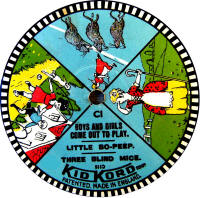 |
||||||||||||||||||||
| Kildare | Kildare was the name that some late Vocalion records were sold under. The records were sold by Selfridges. The labels have a sticker with the "Kildare" name stuck over the "Vocalion" name on the label. They are usually the B-200 series Vocalions, or the very last few X-series (by then in the 10,000 range). In fact, it is extremely rare to find a B-200 series Vocalion without the Kildare sticker (or the remains of one) implying that there may have been legal reasons why the Vocalion name could no longer be used for these records, possibly something to do with the various connections (or lack of them) between Brunswick & Vocalion in Britain & America. |
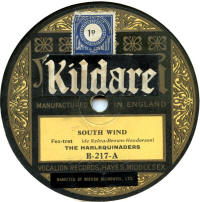 |
||||||||||||||||||||
| Kinderliedjes |
This was a 5½" and 6" record made by Crystalate, recorded by Sound
Recording Company, for export to Holland, containing Dutch-language
nursery rhymes (Kinderliedjes is Dutch for Nursery Rhymes). Like the British "Nursery Rhymes" label (which had the same design), they date to the mid-1920s. My thanks to Peter Oosterhout for making me aware of these and for providing the images and all the information. |
 |
||||||||||||||||||||
| Kinemusic |
This label was produced by Parlophone in the
about 1929-30 and concentrated on light music, presumably for Cinema
use. Known examples use Parlophone's Private Recording (PR-prefix)
matrix numbers believed to date from this period. Based on the copyright
stamp seen on the accompanying image here, they cost about 6/- or 7/-,
which is expensive, about twice the price of a popular HMV of the
period. Thanks to Bill Dean-Myatt for providing the label image. |
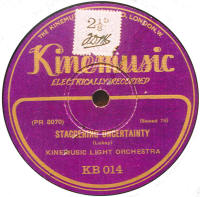 |
||||||||||||||||||||
| King Jazz |
This label was the UK outlet for the American King Jazz
recordings. They were available from late 1949 onwards, but for how
long? They were pressed by Decca. The first record, KJ-1 was also issued
on Vogue with this catalogue number; whether others were also, I don't
know. Thanks to Bill Dean-Myatt for providing the label image. |
 |
||||||||||||||||||||
| Kiskedee |
Made in England by Oriole, from
original recordings made in Trinidad. Thanks to Bill Dean-Myatt for providing the label image. |
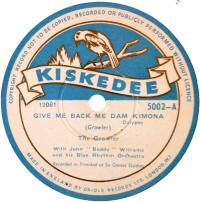 |
||||||||||||||||||||
| Kleartone |
So far this is the only example of this label reported, and at a
guess, I'd say it is the first in a series which may not have gone very
far! It would seem that Kleartone offered a private recording service from their rooms in 14, Percy Street, London, W1. Rather unusually for such companies, the label doesn't really advertise the service, or mention the company name or owner. An advert in The Stage for October 29th, 1931, however, says this is The Kleartone Gramophone Company and refers to their Audition Rooms being available to good recording voices and instrumentalists, and that private recordings are also considered. This gives us an approximate date for the recording of late 1931. The example here is a properly pressed shellac record, with the label pressed in, not pasted on. The master numbers are shown in the images and the series may have started, rather randomly, at 4500. Kleartone would almost certainly have another company press the records, but as I haven't actually examined the record, I cannot hazard a guess as to who that could be. Arthur Cox had previously made a number of recordings for The Gramophone Company, issued on the Zonophone and Homochord labels. First Label image taken from CLPGS "For The Record" 12; other images and information from Jonathan Sanders. |
|||||||||||||||||||||
| Klingsor |
Klingsor
Records were annouced for sale in the summer of 1910. They were sold by
The Klingsor Works of 22-24 Tabernacle Street, London, where British
recordings for the label were also made; the rest of the catalogue made
up from masters either recorded by Polyphon in Germany, or available to
that company. The pressings were by Polyphon in Leizig, Germany.
Originally they were to have been labelled as Polyphon, but "Klingsor"
was decided upon instead as it had a good British reputation for their
British-assembled gramophones. Klingsor records had catalogue numbers (described on the label as "Order No." starting from 8501. The British repertoire had face numbers in the 10000-series. In late 1911, with a change of London agent to The Polyphon Instrument Co, the label name was changed to POLYPHON and existing stocks of Klingsor discs sold off over the next six months by J.G. Murdoch & Co. A listing of this label (combined with Polyphon and Pilot) has been published by the CLPGS. Thanks to Ray Stephenson for the label photo. |
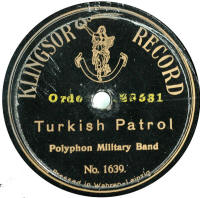 |
||||||||||||||||||||
| Kodak |
This was a Vocalion
product from the early 1920s, made for the Kodak Camera Company
and exported to Australia.
The catalogue ran from Z-500 or 501 into the Z-600s. Please e-mail me with details of ANY of these records. |
|
||||||||||||||||||||
| Kol Zion | Thanks to Bill Dean-Myatt for providing the label image. |
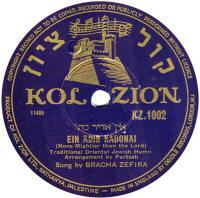 |
||||||||||||||||||||
| Konsert |
Made in England, probably by Decca,
for the South African market and dating to post-WWII. Thanks to Bill Dean-Myatt for providing the label image. |
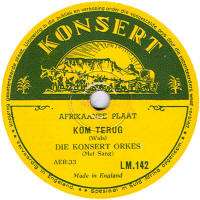 |
||||||||||||||||||||
| Kotoko | Thanks to Bill Dean-Myatt for providing the label image. |
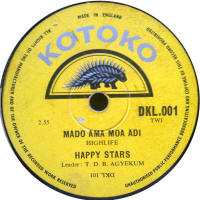 |
||||||||||||||||||||
| KP Music |
Dating from the late 1950s or ealry
1960s, these were produced for the Keith Prowse Publishers and contain
library music. Thanks to Bill Dean-Myatt for providing the label image. |
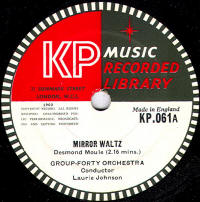 |
